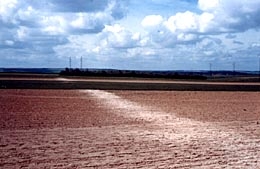- Home
- Clues on the ground
- Pitfalls and confusions
- Telling old and new apart
Crops grow better and display bolder colors over ancient ditches, whether these are circular Bronze Age enclosures or zigzagging World War I trenches.
Construction projects and their many geometric lines can be a source of confusion. One must beware of lines that appear in parallel to current agricultural fields.
This is less true in winter, partly because the different colors of plowed soil are easy to identify in aerial photographs, and partly because immediate, on-the-ground checks, on bare ground that is readily accessible, eliminate any ambiguity.
In summer or springtime, crop growth anomalies often have the same appearance, whether over contemporary, recent, or very ancient remains. Plants grow greener over filled-in trenches from the Great War than over Bronze Age ditches, but they could very well indicate the location of a manure pile or last year's silos!
In plowed fields in wintertime, on the other hand, differences in soil color allow us to distinguish ditches, even on the ground.
Modern trench dug for a pipeline and immediately filled in. Amiens-Nord (Somme).
Between two spring showers, the residual humidity highlights an ancient Roman ditch. Érondelle (Somme).



